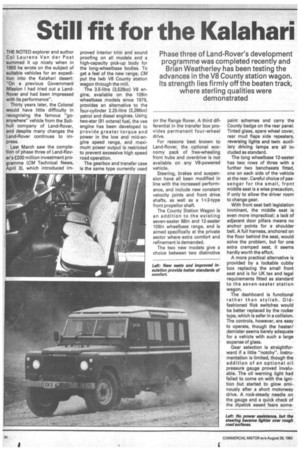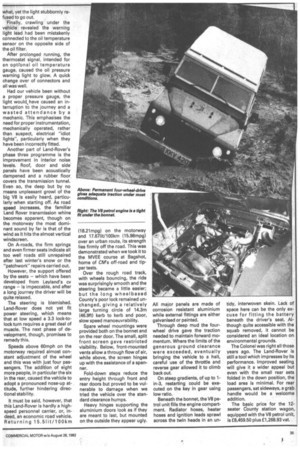Still fit for the Kalahari
Page 28

Page 29

If you've noticed an error in this article please click here to report it so we can fix it.
Phase three of Land-Rover's development programme was completed recently and Brian Weatherley has been testing the advances in the V8 County station wagon. Its strength lies firmly off the beaten track, where sterling qualities were demonstrated
THE NOTED explorer and author Col Laurens Van der Post summed it up nicely when in 1950 he wrote on the subject of suitable vehicles for an expedition into the Kalahari desert: "On a previous Government Mission I had tried out a LandRover and had been impressed with its performance".
Thirty years later, the Colonel would have little difficulty in recognising the famous "goanywhere" vehicle from the Solihull company of Land-Rover, and despite many changes the Land-Rover continues to impress,
Last March saw the completion of phase three of Land-Rover's £200 million investment programme (CM Technical News, April 3), which introduced im
proved interior trim and sound proofing on all models and a high-capacity pick-up body for the long-wheelbase bodies. To get a feel of the new range, CM put the Iwb V8 County station wagon through the mill.
The 3.5-litre (3,528cc) V8 engine, available on the 109in wheelbase models since 1979, provides an alternative to the four-cylinder 2.25-litre (2,286cc) petrol and diesel engines. Using two-star (91 octane) fuel, the yea engine has been developed to provide greater torque and power in the low and mid-engine speed range, and maximum power output is restricted to prevent excessive high speed road operation.
The gearbox and transfer case is the same type currently used on the Range Rover. A third differential in the transfer box provides permanent four-wheel drive.
For reasons best known to Land-Rover, the optional economy pack of free-wheeling front hubs and overdrive is not available on any VB-powered vehicle.
Steering, brakes and suspension have all been modified in line with the increased performance, and include new constant velocity joints and front drive shafts, as well as a 1x2-type front propellor shaft.
The County Station Wagon is an addition to the existing seven-seater 881n and 12-seater 109in wheelbase range, and is aimed specifically at the private sector where extra comfort and refinement is demanded.
The two new models give a choice between two distinctive paint schemes and carry the County badge on the rear panel. Tinted glass, spare wheel cover, rear mud flaps side repeaters, reversing lights and twin auxiliary driving lamps are all included as standard.
The long wheelbase 12-seater has two rows of three with a further two benchseats fitted, one on each side of the vehicle at the rear. Careful choice of passenger for the small, front middle seat is a wise precaution, if only to allow the driver room to change gear.
With front seat belt legislation imminent, the middle seat is even more impractical; a lack of adjacent door pillars means no anchor points for a shoulder belt. A full harness, anchored on the floor behind the seat, would solve the problem, but for one extra cramped seat, it seems hardly worth the effort.
A more practical alternative is provided by a lockable cubby box replacing the small front seat and is for UK tax and legal requirements fitted as standard to the seven-seater station wagon.
The dashboard is functional rather than stylish. Oldfashioned flick switches would be better replaced by the rocker type, which is safer in a collision. The controls, however, are easy to operate, though the heater/ demister seems barely adequate for a vehicle with such a large expanse of glass.
Gear selection is straightforward if a little "notchy". Instrumentation is limited, though the addition of an optional oil pressure gauge proved invaluable. The oil warning light had failed to come on with the ignition but started to glow ominously after a short motorway drive. A rock-steady needle on the gauge and a quick check of the dipstick eased fears some what, yet the light stubbornly refused to go out Finally, crawling under the vehicle revealed the warning light lead had been mistakenly connected to the oil temperature sensor on the opposite side of the oil filter.
After prolonged running, the thermostat signal, intended for an optronal oil temperature gauge, caused the oil pressure warning light to glow. A quick change over of connectors and all was well.
Had our vehicle been without a proper pressure gauge, the light would, have caused an interruption to the journey and a wasted attendance by a mechanic. This emphasises the need for proper instrumentation, mechanically operated, rather than suspect, electrical "idiot lights", particularly when they have been incorrectly fitted.
Another part of Land-Rover's phase three programme is the improvement in interior noise levels. Roof, door and side' panels have been acoustically dampened and a rubber floor covers the transmission tunnel. Even so, the deep but by no means unpleasant growl of the big V8 is easily heard, particularly when starting off. As road speed increases, the familiar Land Rover transmission whine becomes apparent, though on the motorway the most dominant sound by far is that of the wind as it hits the almost vertical windscreen.
On A-roads, the firm springs and even firmer seats indicate all too well roads still unrepaired after last winter's snow or the "patchwork" repairs carried out.
However, the support offered by the seats — which have been developed from Leyland's cv range — is impeccable, and after a long journey the driver will be quite relaxed.
The steering is blemished. Land-Rover does not yet fit power steering, which means that at low speed a 3.3 lock-tolock turn requires a great deal of muscle. The next phase of development, though, promises to remedy this.
Speeds above 60mph on the motorway required almost constant adjustment of the wheel and this was with just four passengers. The addition of eight more people, in particular the six in the rear, caused the vehicle to adopt a pronounced nose-up attitude, further hindering directional stability.
It must be said, however, that this Land-Rover is hardly a highspeed personnel carrier, or, indeed, an economic road vehicle. Returning 1 5.51it/ 1 0 Okm (18.21mpg) on the motorway and 17.671it/100km (15.98mpg) over an urban route, its strength lies firmly off the road. This was demonstrated when we took it to the MVEE course at Bagshot, home of CM's off-road and tipper tests.
Over the rough road track, with wheels bouncing, the ride was surprisingly smooth and the steering became a little easier; but the long wheelbased County's poor lock remained unchanged, giving a relatively large turning circle of 14.3m (46.9ft) kerb to kerb and poor, slow speed manoeuvrability.
Spare wheel mountings were provided both on the bonnet and on the rear door. The small, split front screen gave restricted visibility. Below, front-mounted vents allow a through flow of air, while above, the screen hinges up with the assistance of a spanner.
Fold-down steps reduce the entry height through front and rear doors but proved to be vulnerable to damage when we tried the vehicle over the standard clearance humps.
Heavy hinges supporting the aluminium doors look as if they are meant to last, but mounted on the outside they appear ugly. All major panels are made of corrosion resistant aluminium while external fittings are either galvanised or painted.
Through deep mud the fourwheel drive gave the traction needed to maintain forward momentum. Where the limits of the generous ground clearance were exceeded, eventually bringing the vehicle to a halt, careful use of the throttle and reverse gear allowed it to climb back out.
On steep gradients, of up to 1in-3, restarting could be executed on the key in gear using low ratio.
Beneath the bonnet, the V8 petrol unit fills the engine compartment. Radiator hoses, heater hoses and ignition leads sprawl across the twin heads in an un tidy, interwoven skein. Lack of space here can be the only excuse for fitting the battery beneath the driver's seat. Although quite accessible with the squab removed, it cannot be considered an ideal location on environmental grounds.
The Colonel was right all those years ago. The Land-Rover is still a tool which impresses by its performance. Improved seating will give it a wider appeal but even with the small rear sets folded in the down position, the load area is minimal. For rear passengers, sat sideways, a grab handle would be a welcome addition.
The basic price for the 12seater County station wagon, equipped with the V8 petrol unit, is £8,459.50 plus £1,268.93 vat.








































